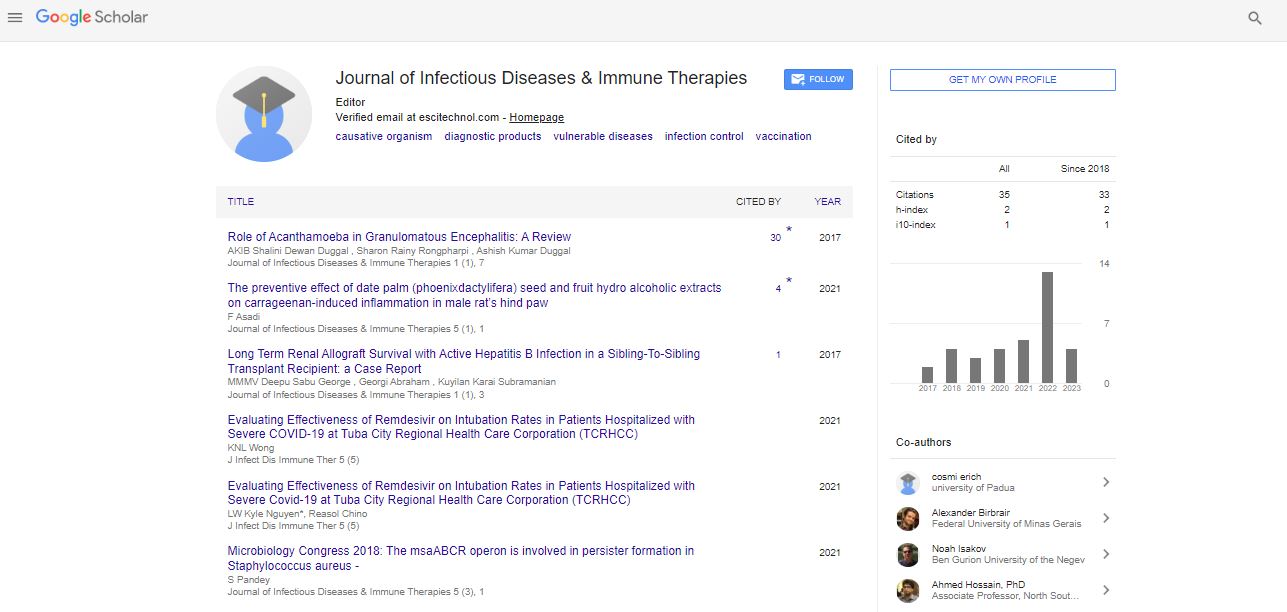Commentary, Vol: 12 Issue: 2
Pathogen-Host Cell Dynamics: The Correlation between Microorganisms and Their Hosts
Gavin Helsen*
Department of Genetics, Stanford University School of Medicine, Stanford, USA
*Corresponding Author: Gavin Helsen
Department of Genetics, Stanford
University School of Medicine, Stanford, CA, USA
E-mail: gavin.helsen@embl.de
Received date: 27 May, 2023, Manuscript No. JIDITH-23-106350;
Editor assigned date: 29 May, 2023, Pre QC No. JIDITH-23-106350 (PQ);
Reviewed date: 15 June, 2023, QC No. JIDITH-23-106350;
Revised date: 23 June, 2023, Manuscript No. JIDITH-23-106350 (R);
Published date: 30 June, 2023, DOI: 10.4172/2329-9541.1000339
Citation: Helsen G (2023) Pathogen-Host Cell Dynamics: The Correlation between Microorganisms and Their Hosts. J Immunol Tech Infect Dis 12:2.
Description
Pathogens are micro-organisms capable of causing disease in their hosts. Understanding the intricate interactions between pathogens and host cells is crucial for developing effective therapeutic strategies. This provides an overview of pathogen cell biology, highlighting the mechanisms employed by various pathogens to invade, survive, and replicate within host cells. By unraveling the molecular and cellular processes underlying these interactions, we can gain valuable insights into the pathogenesis of infectious diseases and devise novel approaches for their prevention and treatment.
Infectious diseases remain a significant threat to global health, causing immense morbidity and mortality worldwide. Pathogens, including bacteria, viruses, fungi, and parasites, employ sophisticated strategies to exploit host cells for their survival and propagation. By delving into the field of pathogen cell biology, we aim to shed light on the mechanisms utilized by these micro-organisms to establish infections, evade host immune responses, and manipulate cellular processes for their benefit.
Pathogens have evolved numerous strategies to gain entry into host cells. Some pathogens use surface adhesion molecules to bind to specific receptors on the host cell surface, facilitating their internalization via endocytosis. Others exploit phagocytic cells to engulf them, allowing entry into the host cell cytoplasm. Additionally, certain pathogens can directly inject their genetic material or effector proteins into host cells through specialized secretion systems. Understanding the molecular basis of pathogen entry provides insights into potential therapeutic targets for blocking infection.
Once inside host cells, pathogens must navigate a hostile intracellular environment. They employ various strategies to survive and replicate, including subverting host immune responses and manipulating cellular processes. Pathogens often secrete virulence factors that interfere with host signaling pathways, disrupt the cytoskeleton, and modulate the host immune response. Some pathogens can reside within specialized compartments, such as vacuoles or inclusion bodies, to avoid detection and destruction by host defence mechanisms. By understanding these strategies, researchers can identify key molecular players and pathways targeted by pathogens and develop therapeutics to disrupt their survival and replication.
The interplay between pathogens and host cells is a dynamic process that involves a complex network of molecular interactions. Pathogens exploit host cellular machinery to acquire nutrients, generate energy, and synthesize essential components for their survival. They can hijack host organelles, such as the endoplasmic reticulum or mitochondria, to create a favorable replication niche. Conversely, host cells have evolved various defense mechanisms to recognize and eliminate invading pathogens. These include pattern recognition receptors that detect pathogen-associated molecular patterns, leading to the activation of immune responses. The delicate balance between pathogen virulence and host defense mechanisms determines the outcome of infection.
Pathogens can inflict substantial damage on host cells through the release of toxins, induction of inflammation, or disruption of cellular homeostasis. Toxins produced by certain bacteria can disrupt cellular membranes, impair cellular signaling, or induce cell death. Viral infections can trigger apoptosis or provoke an immune response leading to tissue damage. Understanding the mechanisms underlying pathogen-induced cellular damage can aid in the development of therapeutics that mitigate tissue injury and promote tissue repair.
Advancements in pathogen cell biology have provided invaluable insights into the intricate interactions between microorganisms and host cells. By deciphering the strategies employed by pathogens to invade, survive, and replicate within host cells, researchers are uncovering potential targets for therapeutic interventions. This knowledge can inform the development of novel antiviral, antibacterial, and Antiparasitic strategies, as well as guide the design of vaccines and immunotherapies. Continued research in pathogen cell biology will undoubtedly contribute to the development of more effective approaches to combat infectious diseases and improve global health outcomes.
 Spanish
Spanish  Chinese
Chinese  Russian
Russian  German
German  French
French  Japanese
Japanese  Portuguese
Portuguese  Hindi
Hindi 